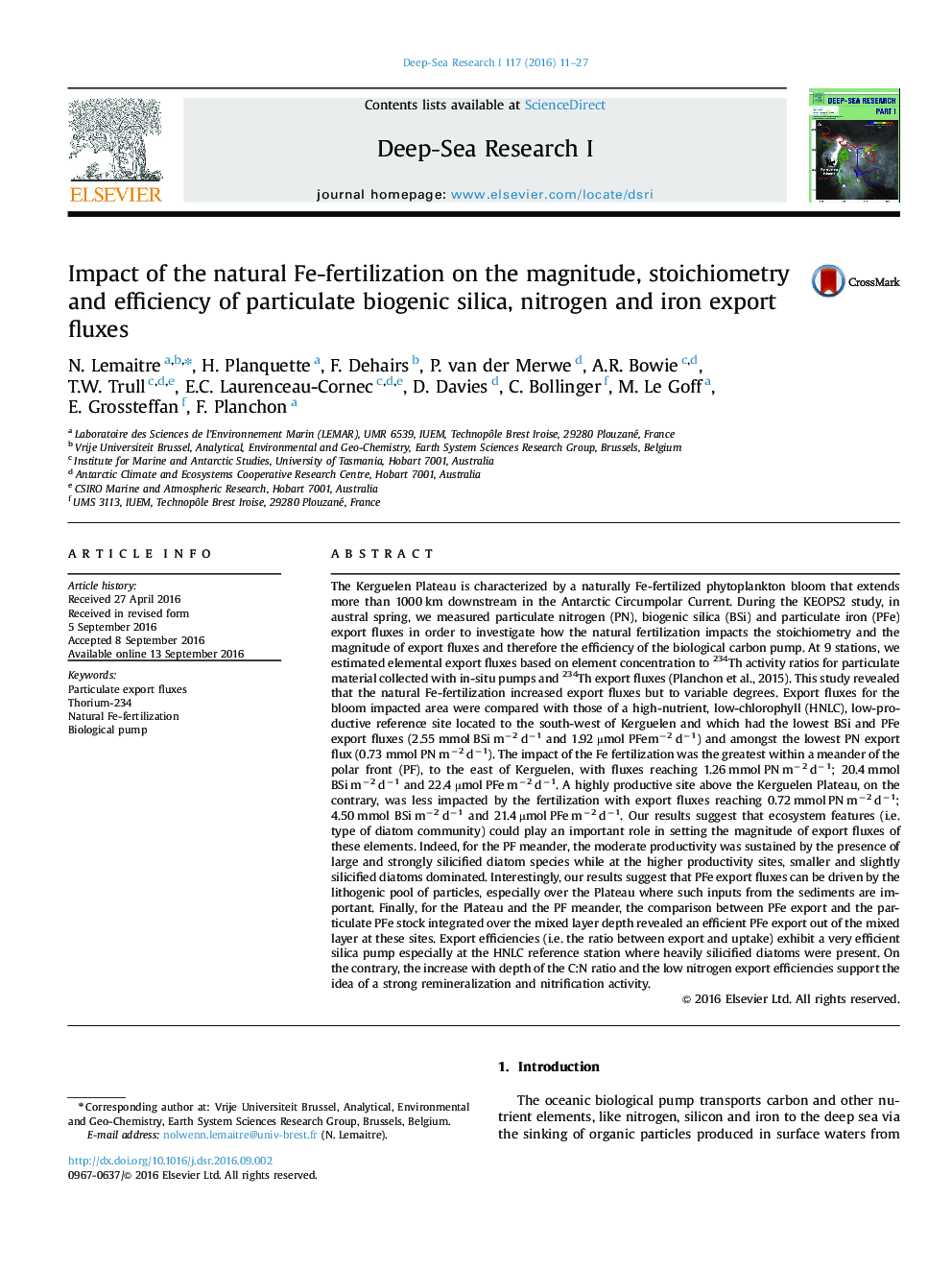| کد مقاله | کد نشریه | سال انتشار | مقاله انگلیسی | نسخه تمام متن |
|---|---|---|---|---|
| 4534372 | 1626313 | 2016 | 17 صفحه PDF | دانلود رایگان |
• Natural iron fertilization induces an increase of PN, BSi and PFe export fluxes.
• Ecosystem plays a key role on the magnitude, stoichiometry and efficiency of fluxes.
• Particulate iron export fluxes are mainly driven by the lithogenic pool of particles.
The Kerguelen Plateau is characterized by a naturally Fe-fertilized phytoplankton bloom that extends more than 1000 km downstream in the Antarctic Circumpolar Current. During the KEOPS2 study, in austral spring, we measured particulate nitrogen (PN), biogenic silica (BSi) and particulate iron (PFe) export fluxes in order to investigate how the natural fertilization impacts the stoichiometry and the magnitude of export fluxes and therefore the efficiency of the biological carbon pump. At 9 stations, we estimated elemental export fluxes based on element concentration to 234Th activity ratios for particulate material collected with in-situ pumps and 234Th export fluxes (Planchon et al., 2015). This study revealed that the natural Fe-fertilization increased export fluxes but to variable degrees. Export fluxes for the bloom impacted area were compared with those of a high-nutrient, low-chlorophyll (HNLC), low-productive reference site located to the south-west of Kerguelen and which had the lowest BSi and PFe export fluxes (2.55 mmol BSi m−2 d−1 and 1.92 µmol PFem−2 d−1) and amongst the lowest PN export flux (0.73 mmol PN m−2 d−1). The impact of the Fe fertilization was the greatest within a meander of the polar front (PF), to the east of Kerguelen, with fluxes reaching 1.26 mmol PN m−2 d−1; 20.4 mmol BSi m−2 d−1 and 22.4 µmol PFe m−2 d−1. A highly productive site above the Kerguelen Plateau, on the contrary, was less impacted by the fertilization with export fluxes reaching 0.72 mmol PN m−2 d−1; 4.50 mmol BSi m−2 d−1 and 21.4 µmol PFe m−2 d−1. Our results suggest that ecosystem features (i.e. type of diatom community) could play an important role in setting the magnitude of export fluxes of these elements. Indeed, for the PF meander, the moderate productivity was sustained by the presence of large and strongly silicified diatom species while at the higher productivity sites, smaller and slightly silicified diatoms dominated. Interestingly, our results suggest that PFe export fluxes can be driven by the lithogenic pool of particles, especially over the Plateau where such inputs from the sediments are important. Finally, for the Plateau and the PF meander, the comparison between PFe export and the particulate PFe stock integrated over the mixed layer depth revealed an efficient PFe export out of the mixed layer at these sites. Export efficiencies (i.e. the ratio between export and uptake) exhibit a very efficient silica pump especially at the HNLC reference station where heavily silicified diatoms were present. On the contrary, the increase with depth of the C:N ratio and the low nitrogen export efficiencies support the idea of a strong remineralization and nitrification activity.
Journal: Deep Sea Research Part I: Oceanographic Research Papers - Volume 117, November 2016, Pages 11–27
